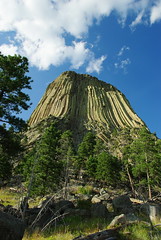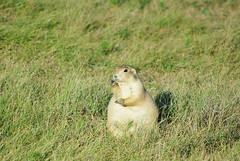Buffalo is situated at the base of the Big Horn Mountains in Northeast Wyoming, at the point where the Northern Great Plains rise into the Northern Rockies. Compared to the vast land area loads of other field offices, the Buffalo Field Office (BFO) manages what is comparably a small land area (780,291 acres) but is the largest office in Wyoming (personnel- wise) due to development of Coal Bed Methane (CBM) in the Powder River Basin, where the BLM manages almost 7 times as much mineral real estate as the surface acreage mentioned. As such, the primary and overwhelming focus of the BFO is related to approving and regulating development of CBM. As a Range and Wildlife Intern at the BFO, my work has inherently been linked into the very controversial issues surrounding the effects of energy development on sensitive wildlife. It has been fascinating to observe (and avoid getting involved in, as much as possible) the tension created between the realistic need to decrease our foreign energy dependence (through extracting more fossil fuels, in this case, and thus trying to responsibly approve development of these resources) and simultaneously protect wildlife, especially sensitive wildlife. Trying to strike this balance, at least from my sidelines observation point, is always controversial, nearly impossible, and keeps all 100+ employees of this office neck deep in work!
One major upcoming news item that will truly affect the BFO is the potential that the greater sage grouse will get listed by US Fish and Wildlife (as an endangered species) within the next few months. Sage grouse populations in the Powder River Basin are struggling, at best, and a listing is likely to create massive chaos for the BFO in their energy development balancing act. Thinking towards the necessary conservation of the Greater Sage Grouse, BFO Biologist Bill Ostheimer (with his trusty intern and seasonal sidekicks) has launched a one year study to investigate whether the two declining Sage Grouse populations in the Powder River and Big Horn Basins (on either side of the Big Horn Mountains) are actually connected by a more robust population that summers in the Southern Big Horns. We have spent a significant part of our time here helping to trap and collar 17 additional Sage Grouse, and locating the birds with radio telemetry to learn where they overwinter, and eventually, where they lek in the spring. In addition to becoming pretty attached to a bunch of birds we hardly ever see, we’ve had great wildlife sightings (Badger Badger), enjoyed some spectacular scenery, succeeded and failed at finding dead/stationary collars, met some local characters, avoided running into top-10 most wanted One-Eyed Ed, run up behind sheep on trail (see photo) and listened to a lot of low-quality radio.
In all, this has been a great opportunity to learn the challenges of public land management, see a spectacular part of the country, gain some valuable field and office skillz, inform my “life-direction” ponderings and add to my already-very-long personal list of things I care strongly about (which can be overwhelming). But as my co-intern would say, “Don’t worry ‘bout it.”
To leave you with one factoid- Buffalo, WY: NOT named after Bison bison as might make sense, but, rather, the town is named after Buffalo, NY- and the name was drawn out of a hat.
-Hannah Specht, BLM Field Office, Buffalo, WY






























